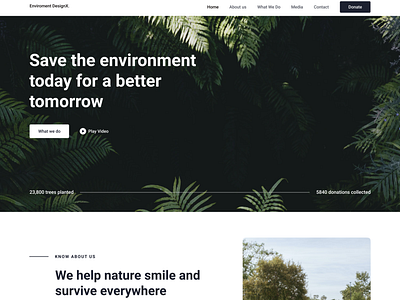Enviroment UI/UX Web Design
Designing an environmental website presents a unique opportunity to promote awareness, education, and action towards environmental conservation and sustainability. Here are some key points to consider when designing an environmental website:
Educational Content: The website should serve as a valuable resource for educating visitors about environmental issues, conservation efforts, and sustainable practices. Incorporate informative articles, infographics, videos, and interactive content to engage users and increase awareness.
Visual Elements: Utilize visually compelling elements such as high-quality images, videos, and graphics to showcase the beauty of nature and highlight environmental initiatives. Visual storytelling can evoke emotions and inspire visitors to take action towards protecting the environment.
Interactive Maps: Incorporate interactive maps to illustrate environmental data, conservation projects, and eco-friendly initiatives in different regions. Interactive maps can help users visualize the impact of environmental issues and discover opportunities for involvement in their communities.
Calls to Action: Encourage visitors to take action by incorporating clear and compelling calls to action (CTAs) throughout the website. Whether it's signing petitions, volunteering for conservation projects, or making donations to environmental organizations, CTAs should inspire visitors to get involved and make a positive difference.
Resource Library: Provide a comprehensive resource library with access to reports, studies, guides, and other relevant materials related to environmental topics. Organize content into categories and make it easily searchable to help users find information quickly and efficiently.
Social Sharing: Include social sharing buttons to enable users to share content with their networks and amplify the reach of environmental messages. Social media integration allows visitors to spread awareness and inspire others to join in environmental efforts.
Accessibility: Ensure that the website is accessible to all users, including those with disabilities. Implement accessibility features such as alternative text for images, keyboard navigation support, and color contrast adjustments to provide an inclusive user experience.
Green Hosting and Design Practices: Practice what you preach by using eco-friendly hosting services and implementing sustainable design practices. Optimize website performance to minimize energy consumption, reduce carbon emissions, and minimize environmental impact.
In summary, effective environmental website design involves creating educational content, incorporating visual elements, utilizing interactive maps, including calls to action, providing a resource library, enabling social sharing, ensuring accessibility, and adopting green hosting and design practices. By focusing on these key points, environmental websites can inspire and empower visitors to become stewards of the planet and advocate for a sustainable future.
Get more info:
